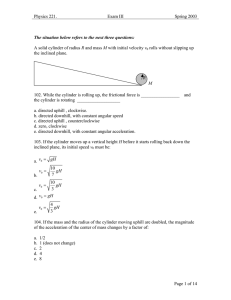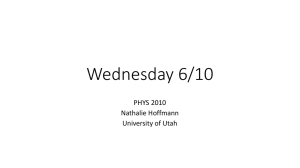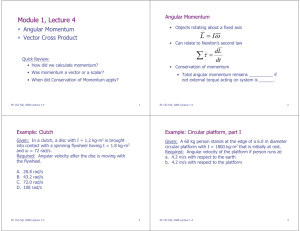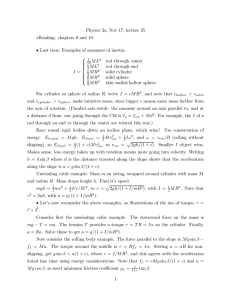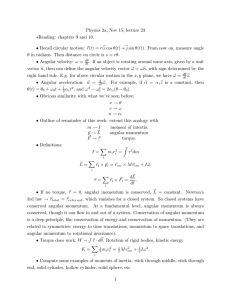Physics 221. Exam III Spring 2003
advertisement
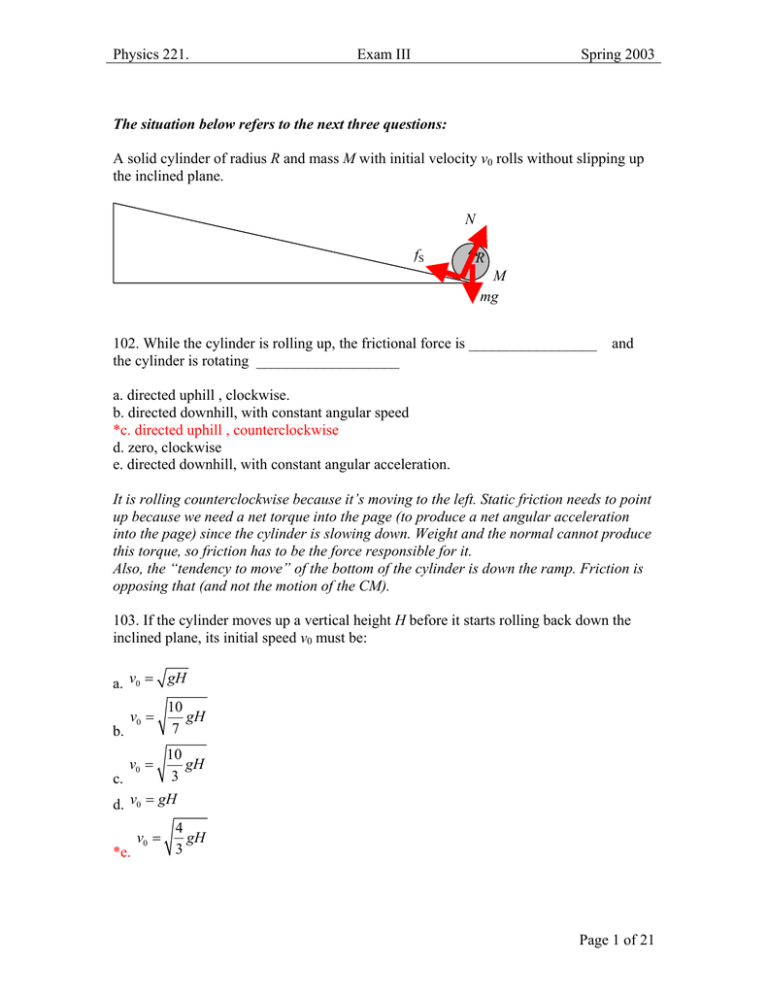
Physics 221. Exam III Spring 2003 The situation below refers to the next three questions: A solid cylinder of radius R and mass M with initial velocity v0 rolls without slipping up the inclined plane. N fS R M mg 102. While the cylinder is rolling up, the frictional force is _________________ the cylinder is rotating ___________________ and a. directed uphill , clockwise. b. directed downhill, with constant angular speed *c. directed uphill , counterclockwise d. zero, clockwise e. directed downhill, with constant angular acceleration. It is rolling counterclockwise because it’s moving to the left. Static friction needs to point up because we need a net torque into the page (to produce a net angular acceleration into the page) since the cylinder is slowing down. Weight and the normal cannot produce this torque, so friction has to be the force responsible for it. Also, the “tendency to move” of the bottom of the cylinder is down the ramp. Friction is opposing that (and not the motion of the CM). 103. If the cylinder moves up a vertical height H before it starts rolling back down the inclined plane, its initial speed v0 must be: a. v0 = gH b. c. v0 = 10 gH 7 v0 = 10 gH 3 d. v0 = gH *e. v0 = 4 gH 3 Page 1 of 21 Physics 221. Exam III Spring 2003 Only conservative forces (weight) do work here, so mechanical energy is conserved, 1 1 2 MvCM + I CM ω 2 2 2 E f = Mgh Ei = Rolling without slipping: vCM = Rω Moment of inertia of a cylinder: I CM = 1 MR 2 2 2 1 11 v 2 + MvCM MR 2 CM = Mgh 2 22 R 3 2 vCM = gh 4 4 gh vCM = 3 104. If the mass and the radius of the cylinder moving uphill are doubled, the magnitude of the acceleration of the center of mass changes by a factor of: a. 1/2 *b. 1 (does not change) c. 2 d. 4 e. 8 To begin with, the calculation in the previous part ended up being independent of M and R. That is an indication of the acceleration being the same. And: We saw a demo in class with two completely different cylinders going down a ramp and reaching the bottom at the same time. Or you can do the calculation. From the free-body diagram above, mg sin θ − f s = maCM 1 mR 2α 2 = Rα fs R = aCM mg sin θ − maCM = maCM 2 fs = mR 2α maCM = 2R 2 aCM = 2 g sin θ 3 Page 2 of 21 Physics 221. Exam III Spring 2003 105. A solid wood door a = 1 m wide and b = 2 m high is hinged on one of the long sides (as a regular door) and has a total mass M = 40 kg. Initially the door is at rest. It is struck with a handful of sticky mud of mass m = 0.5 kg traveling perpendicular to the door at 12 m/s before impact. The mud hits the door at its geometrical center. What is ωf, the final angular speed of the door? (Idoor with respect to hinges = Ma2/3) a. ωf = 0.10 rad/s *b. ωf = 0.22 rad/s c. ωf = 0.43 rad/s d. ωf = 0.56 rad/s e. ωf = 0.80 rad/s There is no external torque on the system door-mud ball, so angular momentum is conserved. The mud hits the door at distance a/2 from the hinges. a Li = m v 2 2 1 a L f = Ma 2ω + m ω 3 2 mv M m = + aω 2 3 4 v 6m ω= = 0.22 rad/s 4 M + 3m a Page 3 of 21 Physics 221. Exam III Spring 2003 106. Four small identical balls are arranged in a square using four massless rods. The system can rotate about three different axis, as shown in the figures below. Rank the moments of inertia of the system in each case. 2 1 3 a. I1 > I2 > I3 b. I1 > I3 > I2 c. I1 = I3 > I2 d. I1 = I2 = I3 *e. I1 > I2 = I3 2 L I1 = 4m 2 = 2mL2 2 2 L I 2 = 4m = mL2 2 2 L 2 = mL2 I 3 = 2m 2 Page 4 of 21 Physics 221. Exam III Spring 2003 107. All the forces applied to the objects (three rods, one disk) in the figure below have magnitude F or 2F. Each object is free to rotate in the plane of the figure about the axis indicated with a dot ●. Compare the magnitude of the net torque about the corresponding axis on each system. 1 2 F L F L L 3 L 4 2F 2F F F L/2 L L a. τ1 < τ3 < τ2 = τ4 *b. τ2 < τ1 < τ4 < τ3 c. τ4 < τ3 < τ 1 = τ 2 d. τ2 < τ1 < τ3 = τ4 e. τ1 = τ2 < τ4 < τ3 The shape of the object doesn’t matter for torque (it’ll matter for the angular acceleration produced by the torque, but that’s a different question). The smallest one is 2 (zero torque) In 4, only the force on the rim matters. The torque is LF. This is a larger torque than in 1, because in 1 the angle between the lever arm and the force is not 90°. In 1, the cross product in the torque picks up the part of the force that is perpendicular to the lever arm, and this is less than the total force. So 4>1 And 3 is the largest of all. It would be equivalent to 4 if the small force was applied at distance L from the axis, but because it’s L/2, the net torque is L 2F − L/2 F = 3/2 LF (greater than LF) . So 3>4 Page 5 of 21 Physics 221. Exam III Spring 2003 The situation below refers to the next two questions: A ladder of mass M = 15 kg and length L = 3 m is put against a frictionless wall as shown in the figure. The floor has a static friction constant µs = 0.25. N1 θ mg N2 f 108. If the angle θ = 10°, the magnitude of the force exerted on the ladder by the wall is: a. 10 N *b. 13 N c. 17 N d. 21 N e. 26 N From the free-body diagram, require Fnet = 0 and τnet = 0: f − N1 = 0 N 2 − mg = 0 mg L sin θ − N1 L cos θ = 0 (torque about the bottom of the ladder) 2 From the third equation: N1 = mg tan θ = 13 N 2 Page 6 of 21 Physics 221. Exam III Spring 2003 The situation below refers to the next two questions: A mass m = 3.0 kg sits on a plank. The plank has length L = 2.0 m and mass M = 2.5 kg. The plank is positioned atop two scales fixed to the ground. Scale 1 is at one end of the plank, scale 2 is a distance D = 1.25 m from scale 1. The 3-kg mass is d = 0.50 m from the end of the plank, as shown in the figure. L N1 L/2 d N2 m M mg Mg Scale 1 Scale 2 D 110. What does scale 2 read (in kg)? a. 1.1 kg b. 2.3 kg c. 2.7 kg *d. 3.2 kg e. 4.3 kg The net torque about any point must be zero. About the left end of the plank, it’s L dmg + Mg − N 2 D = 0 2 L dm + M 2dm + LM 2 N2 = g =g 2D D The scale, in kg, reads: N 2 2dm + LM = = 3.2kg g 2D Page 8 of 21 Physics 221. Exam III Spring 2003 111. If the 3-kg mass is moved to the right to a distance 2d from the end of the plank, the reading on scale 1 _________ and the reading on scale 2 _________. *a. decreases, increases by the same amount that the reading on scale 1 decreases. b. decreases, increases by twice the amount that the reading on scale 1 decreases. c. decreases, increases by one half the amount that the reading on scale 1 decreases. d. increases, decreases by the same amount that the reading on scale 1 increases. e. increases, decreases by twice the amount that the reading on scale 1 increases When d → 2d, N2 must increase (see equation in previous question). The net force must be zero: mg + Mg − N1 − N 2 = 0 N1 + N 2 = ( m + M ) g So if N2 increases, N1 decreases in the same amount. The situation below refers to the next two questions: A thin rod of mass M = 2 kg and length d = 1 m rests on frictionless ice. A ball of putty of equal mass M with an initial velocity v = 5 m/s hits one end of the rod as shown in the figure. After the collision, the putty sticks to the rod. M d v M 112. Which of the following physical quantities is conserved in this process? a. Kinetic energy only. b. Linear momentum only. c. Angular momentum only. *d. Both linear momentum and angular momentum. e. All three (kinetic energy, linear momentum and angular momentum) Since friction is negligible, there is no net external forces acting on the system (weight is there, but it is cancelled by the normal by ice). So total linear momentum is conserved. None of these forces produces an external torque, either, so total angular momentum is also conserved. Kinetic energy is NOT conserved, because this is a perfectly inelastic collision. Some energy is used to stick the objects together. Page 9 of 21 Physics 221. Exam III Spring 2003 113. Find the magnitude of the angular momentum of the system with respect to the center of mass of the system after the collision. a. b. c. d. e. 1.0 kg m2/s * 2.5 kg m2/s 5.0 kg m2/s 10 kg m2/s 25 kg m2/s Since angular momentum is conserved, we can find its magnitude before the collision (it’s easier). The CM of the whole system is half-way between the CM of the rod and the (point-like) putty, because both objects have the same mass. So the distance between the putty and the CM of the system is d/4. Thus L= d Mv 4 Page 10 of 21 Physics 221. Exam III Spring 2003 114. The motion of three different particles 1, 2 and 3 is studied and it is found that the relation between the displacement x and the acceleration a for each of them is: Particle 1: a = 2 x Particle 2: a = −5 x 2 Particle 3: a = 4 x Which of these particles has simple harmonic motion? a. Particle 1 only *b. Particle 2 only c. Particle 3 only d. Particles 1 and 2 only e. Particles 1 and 3 only In order to have SHM, we need a force F proportional to minus the displacement (or potential energy proportional to displacement square). The same applies to acceleration, since a=F/m. So the only good candidate is particle 2. In any case, particles 1 and 3 will not even have oscillatory motions: a displacement x>0 is accompanied by an acceleration a>0, so the particle does not go back to the equilibrium position, but gets further away from it! Page 11 of 21 Physics 221. Exam III Spring 2003 The situation below refers to the next two questions: A block of mass m = 250 g is suspended from a spring with constant k = 85 N/m. The damping constant b = 70 g/s. We assume that the damping force is F =−bv, where v is velocity. 115. How long does it take for the amplitude of the damped oscillations to drop to half its initial value? a. b. c. d. e. * 5.0s 6.0s 7.0s 8.0s 9.0s b A(t ) = A exp − t 2m . The SHM with damping F=-bv has a decaying amplitude amplitude is A/2 when A b t = A exp − 2 2m 1 b t = exp − 2 2m 2m ln 2 t= b 116. During this same time, the mechanical energy of the system changes by a factor of: a. 1/8 *b. 1/4 c. 1/2 d. 1 e. None of the above. The mechanical energy is E= 1 2 kA 2 , so if A is halved, E is four times smaller. Page 12 of 21 Physics 221. Exam III Spring 2003 The situation below refers to the next two questions: Two identical springs of spring constant k are attached to a block of mass m and to a fixed support. Friction can be neglected. F=−kx F=−kx x x x=0 117. What is the frequency of oscillations? a. * b. c. d. e. f = 1 2π 2k m f = 1 2π 4k m f = 1 2π k 2m f = 1 2π k 4m f = 1 2π k m When the block is displaced x to the right, as shown in the figure, TWO forces act on it. Both to the left, and both equal to kx in magnitude. So the net force is 2kx. Therefore, ma + 2kx = 0 d 2x + 2kx = 0 dt 2 d 2 x 2k + x=0 dt 2 m m This is the differential equation of a SHM with angular frequency f = 1 2π ω= 2k m , so 2k m 118. The block is pulled a distance A to the right of the equilibrium position and released from there at t = 0. The position of the block as a function of time can be written as: x = A sin(ωt + φ) with A > 0 Page 13 of 21 Physics 221. Exam III Spring 2003 Set the origin x = 0 at the equilibrium position of the block and take x > 0 to the right (as shown in the figure). Determine the phase angle φ. a. ϕ = −π rad π ϕ =− 2 rad b. c. ϕ = 0 ϕ= π 2 rad *d. ϕ = π e. rad If x = A sin(ωt + φ) , then v = Aωcos(ωt + φ) The initial conditions are x(0) = A, v(0)=0. sin(φ) = 1 cos(φ) = 0 The solution to this is ϕ= π 2 rad. Page 14 of 21 Physics 221. Exam III Spring 2003 119. In the figure, two tiny conducting balls of identical mass m and identical charge q hang from non-conducting threads of length L. If θ = 1.2°, m = 10 g, and x = 5 cm, what is q? L θ L T q x a. q = ± 4.2 × 10−9 C b. q = ± 1.0 × 10−8 C *c. q = ± 2.4 × 10−8 C d. q = ± 5.4 × 10−8 C e. q = ± 9.7 × 10−8 C q Fe mg In the vertical direction, T cos θ − mg = 0 In the horizontal direction, T sin θ − Fe = 0 So Fe = T sin θ = mg tan θ . Since Fe = ke q2 x2 ⇒ q=± x 2 mg tan θ = ±2.4 × 10−8 C ke 120. A proton and an electron are placed at two corners of an equilateral triangle of side length a = 2 × 10−6 m. What is the magnitude of their net electric field at the third corner? a. b. c. d. e. 45 N/C 90 N/C 180 N/C *360 N/C 480 N/C Page 15 of 21 Physics 221. Exam III Spring 2003 Ep a proton Ee electron These are the electric fields due to the proton and the electron separately. They have the q Ee = E p = ke e2 a . Their y-component cancels out, so same magnitude Enet = 2 E p cos 60D = 2ke qe 1 q = ke e2 = 360 N / C 2 a 2 a 121. A surface has area vector A = (2i + 3j + 4k) m2. What is the magnitude of the flux of an electric field E = 5i N/C through this surface? a. b. c. d. e. *10 Nm2/C 15 Nm2/C 20 Nm2/C 25 Nm2/C 0 G G Φ = E ⋅ A = 10 Nm2 / C Page 16 of 21 Physics 221. Exam III Spring 2003 122. Two long, charged, concentric cylinders have radii a = 3 cm and b = 6 cm. The charge per unit length is λin = 2×10−6 C/m on the inner cylinder, and λout = −8×10−6 C/m on the outer cylinder. Find the magnitude of the electric field at r = 4 cm, where r is the radial distance from the common central axis. a. b. c. d. e. E(r) = 2.7×106 N/C E(r) = 3.6×106 N/C E(r) = 4.5×105 N/C E(r) = 5.4×105 N/C *E(r) = 9.0×105 N/C Use a Gaussian cylindrical surface of radius r and length L. Φ= ∫ G G E ⋅ ds = cylinder Φ= E 2π rL = E= side qenclosed ε0 ∫ G G E ⋅ ds = = ∫ Eds = E ∫ ds = EA = E 2π rL side side λin L ε0 λin L ε0 λin = 9.0 × 105 N / C ε 0 2π r The situation below refers to the next two questions: A charge Q is placed near an uncharged metal slab as shown in the figure. Q metal 123. Which of the following statements is true? *a. Both the charge and the metal slab are pulled toward each other. b. Both the charge and the metal slab are pushed away from each other. c. The charge is pulled toward the metal slab, but no force is exerted on the metal slab. d. The charge is pushed away from the metal slab, but no force is exerted on the metal slab. e. There is no net electric force on either of the two objects. Page 17 of 21 Physics 221. Exam III Spring 2003 The point charge polarizes the metal slab. Alike charge moves to the bottom surface and opposite charge to the upper surface. Thus the repulsion due the alike charges is weaker than the attraction be alike charges. The forces always act on both object, since it’s a third law pair. 124. The metal slab is grounded. The charge is taken away (to infinity) and then the grounding is cut. After this process, the net charge on the slab is: a. 2Q b. Q *c. 0 d. −Q e. −2Q The grounding is cut AFTER the charge is taken away. So by then, all the charge is uniformly distributed once again and no charge flow to/from the ground. Page 18 of 21 Physics 221. Exam III Spring 2003 125. The figure below depicts a uniformly charged sphere with net charge Q > 0 and a concentric Gaussian sphere of radius r around it. The net electric flux through this surface is Φ. If a positive point-charge is brought to point P, the net electric flux through the Gaussian surface _________ and the magnitude of the net electric field at point R (on the Gaussian surface) __________. r R Q>0 P Gaussian sphere a. decreases, decreases b. increases, stays the same c. increases, increases *d. stays the same, decreases e. stays the same, stays the same The net flux through a closed is proportional to the charge enclosed by the surface Gauss’s theorem). So it doesn’t change. But this doesn’t mean that the electric field does not change. It can change, as long as the changes leave the flux as before. towards In this case, the sphere produced an electric field away from the sphere at R. When a positive point charge is placed at P, it produces an electric field away from it, so towards the sphere. Thus the net electric field is now smaller than before. 126. The potential energies associated with four orientations of an electric dipole in an electric field are (1) 3U, (2) 4U, (3) 5U, (4) −3U, (5) −5U, where U is positive. Rank the orientations according to the angle between the electric dipole moment p and the electric field E, smallest first. a. b. c. d. e. 1, 2, 3, 4, 5 5, 4, 3, 2, 1 *5, 4, 1, 2, 3 1, 2, 3, 5, 4 3, 2, 1, 4, 5 G G U = − p ⋅ E = − pE cos θ , where θ is the angle between The potential energy of a dipole is the dipole moment and the electric field. So as θ increases, the potential energy increases. Therefore, the smallest angle must be when the potential energy is -5U, next 3U, next 3U, etc. Page 19 of 21 Physics 221. Exam III Spring 2003 127. The figure below shows the electric field lines in a region of space. The direction of one of the lines is given. Q q Which of the following statements about the two charges, Q and q, is true? a. |Q| < |q|, Q>0 b. |Q| < |q|, Q<0 c. |Q| = |q|, Q>0 d. |Q| > |q|, Q>0 *e. |Q| > |q|, Q<0 Electric field lines point away from + charge and towards − charges. So q must be positive, and all its lines point away from it. Then, lines point towards Q, so Q is negative. The number of lines is proportional to the charge. 8 lines go towards Q but only 6 away from q, so |Q| > |q| Page 20 of 21 Physics 221. Exam III Spring 2003 128. The figure below shows three arrangements of a charge q (in gray) and several charges Q and 2Q (in white). Rank the arrangements according to the magnitude of the net electrostatic force on charge q due to the other charges. q d q Q Q d d Q Q Fig 1 d Fig 2 d q 2Q Fig 3 a. F2 < F3 = F1 b. F3 = F2 < F1 c. F2 = F1 < F3 *d. F2 < F1 < F3 e. F1 = F3 < F2 Draw the contribution of each charge Q (red vectors, always equal magnitude) and vector-sum them to find the net force (blue arrow). The smaller the angle between the red vectors, the larger the resultant (This is true as long as the angle is less than 120°). Page 21 of 21
